
JAPANESE PRINTS
A MILLION QUESTIONS
TWO MILLION MYSTERIES
Ukiyo-e Prints浮世絵版画Port Townsend, Washington |
|
A CLICKABLE INDEX/GLOSSARY (Hopefully this will be an ever changing and growing list.)
Mom thru N |
|
|
The gold koban coin on a blue ground is being used to mark additions made in June 2008. The red on white kiku mon was used in May. |
|
|
|
TERMS FOUND ON THIS PAGE:
Momiji-gari, Momoyamajidai, Mon, Monogatari, Murasaki, Murasaki bōshi, Murasaki Shikibu, The Mustrard Seed Garden Painting Manual, Myōseki, Naga-bakama, Nagasaki, Nagasaki-e, Naginata, Nakamura Shikan, Nakamura Utaemon III, Nakanochō, Namazu, Neko, New Kabuki Encyclopedia: A Revised Adaptation of kabuki jiten, Nichiren, Nigao-e, Nihachi, Nihon zutsumi, Ninja, Niō, Nise Murasaki inaka Genji, Nishiki-e, Noh,
Norimono, Nunobiki,
Nurude
and
Nusa
紅葉狩, 桃山時代, 紋, 物語, 紫, 紫牟子, 紫絵, 紫式部, 長袴, 長持, 長崎, 長崎絵,
投げ頭巾, 薙刀,
中村芝翫,
三代中村歌右衛門,
中野町, 鯰, 鯰, 猫, 根生, 日蓮,
布目摺, 白膠木 and 幤
もみじがり, ももやまじだい, もん, ものがたり, むらさき, むらさきぼうし, むらさきえ, むらさきしきぶ, かいしえんがでん, みょうせき, ながばかま, ながもち, ながさき, ながさきえ, なげずきん, なぎなた, なかむらしガン, さんだい.なかむら.うたえもん, なかのちょう, なまず, なし, ねこ, ねおい, にちれん, にがおえ, にはち, にほんづつみ, にんじゃ, にんぎょ, etc.
|
|
|
Momiji-gari |
紅葉狩
もみじがり |
Whenever two American
upper middle-class individuals or families meet each other for the first
time and if they converse long enough eventually one will ask the other
"Have you ever driven through Vermont (
バーモント)
To the left is a detail taken from a Yoshiiku print. While it would appear to be a maple leaf viewing I wouldn't swear to it. This image was sent to us from our generous contributor Eikei. Thanks Eikei! |
|
Momoyamajidai |
桃山時代 ももやまじだい |
Momoyama period (1583-1602) |
|
Mon |
紋
もん |
A family crest or coat of arms. Other terms used for such crests are jomon (定紋 or じょうもん) and kamon (家紋 or かもん) 1, 2
Souce and quote: "Edo Architecture and Tokugawa Law", by William H. Coaldrake, Monumenta Nipponica, Vol. 36, No. 3. (Autumn, 1981), footnote 13, pp. 270-2.
By the 19th century only certain daimyo were allowed to affix their family crests to their front gate. (p.274)
These rules are actually not so surprising since there seem to have been edicts governing every aspect of life. However, such restrictions were only as good as the power behind them. Hence, many were basically ignored. I can't vouch for this one.
|
|
Monogatari |
物語 ものがたり |
A story, tale or legend as in the Heike Monogatari (平家物語 or へいけものがたり) or the Genji Monogatari (源氏物語 or げんじものがたり) |
|
Murasaki |
紫
むらさき |
Murasaki or shikon (しこん): A fugitive purple dye which often fades to gray. Like so many other dyes this one is fascinating if only for the discovery of its original properties. The leaves are green and the flowers are white, but the roots...the roots are another story and the source of this colorant. Some sources say it is native to Japan while others say that it was the Chinese who first used its dyes.
The cell color to the left and below is murasaki purple.
Don't forget that color descriptions are not exact. As there are many shades of green or blue for example, there are many slight variations within each of the colors shown here which may or may not conform precisely to your own perceptions of what they should be. |
|
According to Amanda Mayer Stinchecum in Kosode: 16Th-19th Century Textiles from the Nomura Collection: 16th-19th Century Textiles from the Nomura Collection (pp. 202-3) the Lithospermum erythrorhizon is a perennial plant which grows in mountains and fields to 30 to 60 cm. The roots were "...harvested in the fall, dried and stored for several months before use." These contain shikonin which is a naphthaquinone derivative. For optimum effect the plant should be at least three to four years old.
Ideally the roots should be soaked and pounded in 60° water in winter. The intensity of the dye ranges from a keshi murasaki or lilac gray to a waka murasaki or light purple to kōki murasaki or dark purple. The color when used for fabrics will deepen when stored away from light for up to one year.
In England this plant is known as the gromwell.
The photo of the murasaki flowers to the left was sent to us by Shu Suehiro. It was taken on May 29, 2004 at the Uji Botanical Garden (宇治市植物公園) in Kyoto prefecture. According to Shu it is difficult to find this plant in the wild.
Shu runs a wonderful Japanese botanical web site. We would urge you to visit it at http://www.botanic.jp/index.htm. |
||
|
|
||
|
Murasaki bōshi |
紫牟子
むらさきぼうし |
A silk cloth worn by an onnagata at the top of the forehead where the shaved forelocks would have been. Often the cloth is purple, but not always. Cautionary note: Not all onnagata are portrayed on prints wearing this cloth. 1
Professor Leiter has an informative entry on the murasaki bōshi in his New Kabuki Encyclopedia: A Revised Adaptation of kabuki jiten (p. 423). He translates it literally as 'purple headgear'. According to Leiter Torii Shōshichi was the first onnagata to wear this in the 17th century. "Although boshi now means a hat, it did not when this term was coined." Originally this attachment to the wig was worn during special ceremonies ostensibly to keep dust of the actor's forelock. However, after they were forced to shave that part of their hair handsome young actors began wearing "...a fashionable man's silk band (yarō bōshi) on their heads in order to maintain their physical attractiveness. This proved effective as it not only made the actor's face seem smaller, but introduced a nice variation between the whit skin and the black hair." |
|
Murasaki-e |
紫絵
むらさきえ |
A category of pictures in which purple was used extensively while the use of red was avoided.
The image to the left is by Eishi and was sent to us by a very generous contributor. Thanks! |
|
Murasaki Shikibu |
紫式部 むらさきしきぶ |
The author of The Tale of Genji. |
|
This 11th century masterpiece by Lady Murasaki (ca. 973-1014) is considered by many sources to the first great novel written anywhere. Not only that it has remained an adored classic among the Japanese through the centuries and has infiltrated many of the various layers of the culture.
Almost nothing is known about the life of this author. She is believed to have died in ca. 1014. She was born into a family which had turned increasingly to literary pursuits. Even though the study of Chinese poetry was mainly a masculine domain she showed a precocious ability in this field. In 999 she was married to Fujiwara Nobutaka who was many years her senior. Two years later she was a widow. In 1006 or 1007 she entered the service of one of the major consorts of the emperor Ichijō. There she was surrounded by witty and brilliant talents who must have stimulated her latent abilities.
Source: The Princeton Companion to Classical Japanese Literature, by Earl Miner, Hiroko Odagiri and Robert E. Morrell, 1985, p. 202.
Even the name, Murasaki Shikibu, is somewhat shrouded in mystery.
"She seems to have been known during her lifetime as Tō no Shikibu... Tō, the Sino-Japanese reading for the character fuji or 'wisteria,' clearly designates the Fujiwara family, to a cadet branch of which she was born. Shikibu refers to the Shikibushō or Ministry of Rites, in which both her father and brother held office.
Two theories have been advanced to explain the Murasaki element: that because it means 'purple' it refers to the wisteria of her family name; and that it derives from the name of Genji's great love in the Genji monogatari."
Note that very few names of women from that period are known to us today.
Source and quote from: Kodansha Encyclopedia of Japan entry by Edward G. Seidensticker (vol. 5, p. 267). |
||
|
|
||
|
The Mustard Seed Garden Painting Manual |
芥子園画伝
かいしえんがでん
|
There was very little cultural contact with China in the 18th century. That is why the publication in 1753 of "The Mustard Seed Garden Painting Manual" hit the Japanese marketplace with such a bang. There was a thirst among many Japanese artists for a clear understanding of Chinese painting. "It offered age-old principles, practical advice, dozens of actual pictures, and a might dose of encouragement.... it quickly became the philosophical bible of a new generation of painters who were already looking to China for inspiration and example."
I am mentioning this for two particular reasons: "Here is the first use of wood grain [ita-mokuhan] as a pattern, the first use of gradation printings [bokashi], the first use in prints of contrast of texture and color saturation: the result is printed textures that look like colored acquatint."
Source and quotes: Ehon: The Artist and the Book in Japan published by the New York Public Library and the University of Washington Press, 2006, p. 82.
A cultural phenomenon: Decades ago a great scholar told me that "The Mustard Seed Garden Painting Manual" was far more popular in Japan than it ever was in China. It first appeared there in 1679.
Like so many other ehon this was published in several volumes over several years - not to mention later editions. The examples to the left originally appeared in 1748. However, these probably are from a later date, but still from the original blocks. At our request our great contributor E. sent us this bird and flower page. Thanks E!
The detail of the pomegranate gives a sense of the care used to translate the Chinese version into a marketable Japanese commodity. |
|
Myōseki |
名跡
みょうせき |
Most translations of myōseki as 'family name' do not even come close to the true usage of this term. In the West we have a number of practices that hardly exist in the East: kings and queens, the nobility, popes and even certain families are in the habit of naming new members after previous ones. The popes are the only ones among this grouping who rarely if ever have any blood relationship to their predecessors - unlike certain earlier periods - but who adopt their names all the same - of course, with the addition of the next sequential number. |
|
In Japan there is a different practice: In sumo, the theater, and among courtesans it is considered an honor to have the name of a famous predecessor bestowed upon you. In the case of kabuki it often involved the adoption of an young trainee who lived up to expectatios. In the arts Hiroshige I is followed by his adopted son, Hiroshige II, who also married the master's daughter. Toyokuni II was the son-in-law of Toyokuni I.
The same succession lines were true of famous courtesans who were renowned for their beauty and their skills both on and off the mattress. Courtesans had only a few short years to reach the top, burn brightly and then dim only to be replaced by younger, more supple women. If a truly famous courtesan of one house attained a reputation comparable to that of another famous earlier beauty of that house the new one might be allowed to use the name of her predecessor.
If we practiced this in the West there probably would have been a Marilyn Monroe (マリリンモンロー) II or III, several Rembrandts or even have been cursed by a Beethoven (ベートーヴェン) V or VI by now. Thank goodness we haven't. Let's leave that custom to the Japanese who seem to do quite well with it - but not always.
One more note - and I am not absolutely positive about this - but the Jews never name children after their parents directly either for religious or superstitious reasons. I add that only because of the great variances between different cultures. All of this fascinates me.
The image to the left is a detail from a print by Eizan from the 1830s. It shows the courtesan Hanamurasaki. Cecilia Segawa Seigle in her Yoshiwara: The Glittering World of the Japanese Courtesan (pp. 127 and 128) noted: "Thus the last of the legitimate tayū was Hanamurasaki, whose name disappears after the New Year 1761..." Later she added: "One notes that the names Hanamurasaki and Komurasaki were immediately transformed into succession names of the lower-rank sancha in 1762 at the Corner Tamaya. Yet the hallowed tayū name Takao was never again used at any house after 1761. |
||
|
|
||
|
Nagabakama |
長袴
ながばかま
|
Long ceremonial trousers: To the left is a detail from a print by Toyokuni III. Although the figure is kneeling you can clearly see the length of the right pant leg. It would still be long and dragging even if he were standing.
The image to below is by Yoshiiku from 1867, but representing Shimizu Muneharo
(清水宗治 or しみず.むねはる: As a child my parents sometimes bought me pants which were too long expecting me to grow into them. That saved them on money and shopping and I was instructed to roll up my cuffs. But being a child this didn't always work so well and there were numerous times when I tripped or even fell on my face. Recently that memory was brought back to me when I ran across an entry on nagabakama. I always wondered how and why grown men would wear such attire. Now I know. "The long culottes dragged on the floor as the samurai moved acress a room and made it difficult for their wearer to engage in any surprise moves during a court appearance before the shogun." That makes sense.
Quote from: Matsuri: Japanese Festival Arts, by Gloria Granz Gonick, UCLA Fowler Museum of Cultural History, 2002, p. 70. 1
See also our entry on hakama. |
|
Nagamochi |
長持
ながもち
|
A large oblong chest for clothing and other personal possessions. "Nagamochi (long chest) is now seen only as an ancient relic in old families or among museum collections, but up to the early Meiji ear, it was an important household necessity.... Nagamochi appeared first in the 11th or 12th century..." Originally they may have been made of woven bamboo, but in time they were most frequently made of paulownia or white fir because of their lightness and abilities to stay somewhat dry. In time wealthier households had more elaborate chests which were often lacquered and decorated with family crests. In fact, these became a matter of pride when parents could provide their daughters with such chests as a part of their dowries. Sectioned tansus with drawers were a later invention.
Source and quotes: Mock Joya's Things Japanese, p. 38.
The images to the left are two details from prints by Hokusai. However, I have to admit that I am so abysmally ignorant about the fine points of Japanese furniture that I am only guessing that these images represent nagamochi. The one above is from a Chūshingura scene with one figure standing atop a large orange colored chest. The one below shows laborers struggling to keep a similar chest afloat while fording a river.
The fellow standing atop the chest in the top image is Amakawaya Gihei (天川屋義平 or あまかわ.ぎへい) from Act X of the Chūshingura. 1 |
|
Nagasaki |
長崎 ながさき |
Port city used for foreign trade 1 |
|
Nagasaki-e |
長崎絵
ながさきえ
|
"The presence of artists in Nagasaki was not accidental since the government employed copyists to reproduce line for line all pictures and paintings that were imported... It is supposed that the Nagasaki prints were designed by such men as a sideline. The prints were usually unsigned and of those few that do carry a signature...little is know of the artists. These prints were published and sold in Nagasaki itself - presumably as souvenirs. The printing techniques were similar to those used in Edo, although the sizes of paper used were often larger and the pigments were slightly different... They all seem to be decidedly rare."
Quoted from: The Art of Japanese Prints, by Richard Illing, Gallery Books, 1980, p. 155.
The center image to the left is the full print. The top and bottom are details of that print. We really want to thank the fellow who sent this image to us so we could post it for you to see. One of these days I will find a way and place to post the full image in a large format. It is truly beautiful and perhaps the finest examples of Nagasaki-e I have ever seen. Of course, that is a personal opinion and simply a matter of taste. |
|
Nage-zukin |
投げ頭巾 なげずきん
|
A gauze hat or hair covering. |
|
Naginata |
薙刀
なぎなた |
Halberd: "The naginata was the principal weapon of foot troops from the 11th century until well into the 15th century. It was the favorite weapon of Buddhist warrior-monks. Early naginata tended to have shorter shafts and longer blades than those of the 17th century onward, when samurai women were trained in their use. Contrary to common belief, the naginata remained in the arsenal of men until the abolition of the feudal system following the Meiji Restoration (1868)."
Generally the wooden shaft was 4 to 8 feet in length with a curved blade that was 1 to 2 feet long. At the bottom of the shaft was an iron cap.
Source and quote: Kodansha Encyclopedia of Japan entry by Benjamin H. Hazard (vol. 5, p. 308)
The image to the left is a detail from a print by Kuniyoshi from ca. 1840.
|
|
Nakamura Shikan |
中村芝翫 なかむらしガン |
Kabuki actor's name, but here the name of a fictitious twin brother of Nakamura Utaemon III 1 |
|
Nakamura Utaemon III |
三代 中村歌右衛門
さんだい.なかむら うたえもん |
Kabuki actor: 1778-1838 -In the early 1820s Utaemon seriously twisted his leg in Edo. In 1825 in Osaka he injured it again and became extremely ill. "A week later he had recovered enough to continue acting through the end of the second month when the New Year's performances ended, but billboards had already announced a 'retirement performance' [isse ichidai kyogen] for the next month."
Source and quote from: The Theatrical World of Osaka Prints, by Roger S. Keyes and Keiko Mizushima, Philadelphi Museum of Art, 1973, p. 98.
"Utaemon's 'retirement' performance was so well received, and his spirits and health so revived, that he never left the stage, but continued acting without pause until his death at the age of sixty in 1838."
Ibid., p. 100
Michael Jordan retired from basketball only to return to it later. Sugar Ray Leonard retired several times. This is not uncommon with boxers. So, is it any surprise that Utaemon III decided to stay on the stage for another fourteen years after it was announced he was leaving?
For much more information about Utaemon click on the number in the column to the right. 1 |
|
Nakanochō |
中野町
なかのちょう |
The main boulevard running directly through the Yoshiwara or red-light district of Edo. Although it was only a few blocks long it was memorialized in many prints which often showed the procession of the oirans and their attendants dressed in the finest garb.
"The third of the major events of the Yoshiwara had its beginning in 1741. In the spring of that year, proprietors of Nakanochō teahouses conceived the idea of beautifying the boulevard by planting cherry trees and applied for permission from the authorities to do so. It is said they were denied permission for planting trees and were told to use potted cherry plants with blossoms instead."
Quote from:
Yoshiwara: The
The image to the left is a detail from a polyptych by Toyokuni I showing the oirans and their retinues viewing the cherry blossoms on the Nakanochō. |
|
Namazu |
鯰
なまず |
Giant catfish - believed to be the cause of earthquakes - or so I thought. There is an extremely informative web site written by Gregory Smits at Penn State University which gives the most thorough history of the namazu which I have seen in English so far. (Here is a link to that page: http://www.east-asian-history.net/textbooks/172/ch8.htm ) Note that Dr. Smits gives a load of links to other namazu imagery or other relevant sites. This is my summary of his information as best I understand it.
|
|
1. The namazu is Not exactly/actually a catfish: "The Japanese word namazu refers to a wide variety of fish that in English might be called catfish or bullheads. Generally, namazu does not refer to a specific species of fish. In artistic and literary contexts, it is often best to think of namazu less as actual fish swimming around in waterways of Japan than as cultural symbols. And what did namazu symbolize? When it first made an appearance in a work of Japanese highbrow art at the start of the fifteenth century, we cannot determine with certainty what namazu symbolized. As time went on, however, these metaphorical fish gradually began to symbolize disorder. By they [sic] late eighteenth century, the namazu typically stood for one specific type of disorder: earthquakes." A whole genre of namazu pictures developed immediate after the quake of 1855, but in time this fish became a political satire stand in for "...(puffed up) government officials...", etc.
Note: The two major on-line kanji sources I use both give namazu as catfish.
2. In the 15th century there were various explanations for earthquakes based mainly on Chinese concepts. One theory is that quakes were caused by dragons which were referred to as namazu. In time this word seemed to morph into meaning a giant catfish. In fact, it was believed that it could be the movement of any large mythic animal which supported the earth. Or, it could even be the result of male and female deities having sex. There were other theories, but I like that last one best.
3. In the early 15th century the concept of catching or controlling a catfish with a gourd became popular. According to Dr. Smits this was not a Zen kōan, but did become a stock metaphor for attempting the impossible. By the 17th century folk art images were sold to pilgrims in the city of Ōtsu. "...one popular motif... was the image of a person, or, more typically, a monkey, suppressing a giant namazu with a bottle gourd." For centuries the term hyōtan-namazu (瓢箪鯰 or ひょうたん.なまず) or gourd-namazu was used for trying the impossible. This term is hardly used or understood today. "During the eighteenth century, the notion developed that the deity of the Kashima shrine [Kashima daimyōjin 鹿島大明神 or かしま.だいみょうじん] just NE of Edo (Tokyo) pressed down on an oval-shaped boulder called the 'foundation stone' (kamame-ishi [要石 or かなめいし]). This boulder, in turn, pressed down on the head of a huge underground namazu." Occasionally the shrine god would have to leave town for a meeting at the Izumo shrine. At those times Ebisu (or even Daikoku) would take over. If any of them was ever distracted, inattentive or fell asleep the namazu would thrash about causing an earthquake. "(Incidentally, there was an alternative explanation in which the movement of a giant pheasant located at the Kashima Shrine caused earthquakes.)"
4. After the quake of 1855 two different types of namazu were considered: The destructive and the restorative. Actually even the destructive kind could act in a restorative manner. Cities had to be rebuilt. Lives had to be made whole again. Many people often felt the quake was retribution for imagined and real ills. This is not far removed from the Judeo-Christian concept behind the destruction of Sodom and Gomorrah or even the invocations used by modern theologians in their attempts to explain the destruction wrought on September 11, 2001 and/or the flooding of New Orleans following hurricane Katrina in 2005.
***** In 1964 Cornelius Ouwehand published his Namazu-e and Their Themes: An Interpretative Approach to Some Aspects of Japanese Folk Religion. In that volume he noted that the Kashima deity sometimes suppressed the namazu with a sword too and that in certain prints the giant catfish might be replaced by a whale. In a book review by M. E. in the Monumenta Nipponica it is noted that "The interpretation of the namazu pictures is further complicated by the appearance of the fish in human form, as child, as a man or woman, as a representative of various crafts and trades, but still showing a connection with the gourd or water or both by a distinctive mark on his clothes. At times the namazu as causer of earthquakes is abused and hated, at times he is adored as avenger of social injustices ..." M. E. continues "Besides their religious significance in connection with the earthquake legend we find in the pictures also criticism of existing social conditions through ridicule, irony and puns on words."
Who is the Kashima deity? Ouwehand traced the history according to M.E.: "In the myths the god Kashima is Takemikazuchi which arose from the blood of the fire-god Kagutsuchi when his father Izanagi killed him with his sword. Takemikazuchi is the sword-fire-god and thunder-lightning god at the same time." M. E. is critical of the jumble of concepts dealt with by Ouwehand. However, I wasn't quite sure which jumble he was referring to. If it was the dual nature of the namazu then time and scholarship seem to be on Ouwehand's side. |
||
|
|
||
|
|
梨
なし |
Japanese pear: This fruit has no particular connection with ukiyo-e. However, I am reading The Pillow Book of Sei Shōnagon in the Penguin Classics version, translated and annotated by Ivan Morris. This is a book everyone interested in traditional Japan should read. Sei Shōnagon is a woman who doesn't seem to have thought twice about expressing her prejudices and one of them was about the nashi. It was too juicy not to include here. In her section on flowering trees she said: "The blossom of the pear tree is the most prosaic, vulgar thing in the world. The less one sees this particular blossom the better, and it should not be attached to even the most trivial message. The pear blossom can be compared to the face of a plain woman; for its coloring lacks all charm. Or so, at least, I used to think. Knowing that the Chinese admire the pear blossom greatly and praise it in thier poems, I wondered what they could see in it and made a point of examining the flower. Then I was surprised to find that its petals were prettily edged with a pink tinge, so faint that I could not be sure whether it was there or not." She then recalls that the pear blossom was compared to the face of Yang Kuei-fei and decides that "...it really is a magnificent flower."
Two items: Morris notes that Sei Shōnagon is mistaken about the comparison of the flower to the face of Yang Kuei-fei. Actually her visage was compared to the delicacy of jade. And, in a footnote he adds: "It was customary to attach flowers or leaves to one's letters; the choice depended on the season, the dominant mood of the letter, the imagery of the poem it contained, and the colour of the paper."
For our comments on the Yang Gui-fei motif in Japanese art go to our entry on our Yakusha thru Z index/glossary page.
In the Chinese poem, "A Song of Unending Sorrow", by Bai Juyi's (772-846) Yang Gui-fei's spectre is described after death as thus:
Her face, delicate as jade, is desolate beneath the heavy tears, Like a spray of pear blossoms in spring, veiled in drops of rain.
The image of the pear blossoms is from the web site operated by Shu Suehiro at http://www.botanic.jp/index.htm. |
|
Neko |
猫
ねこ |
Cat(s): Also an affectionate term for a geisha. (See our entry on shamisen.)"
The character used for cat in China is the same as the one used by the Japanese - 猫. However, in China it is referred to as a mao "...given to it in imitation of its mewing, but the composition of this name is intended to express an animal which catches rats in grain. [The italics are those of the author C.A.S. Williams.]
Chinese characters are often created from the combination of certain basic elements, but I am not one who is accomplished at parsing these. The left hand element (i.e., the radical) which means 'dog' or 'animal' works well with the right hand element which means 'seedling' when standing alone.
I want to thank our great contributor Eikei for helping me with a clear understanding of this kanji character. |
|
Neoi |
根生 ねおい |
"'Root-born,' an actor who is a true-born son of a vicinity where the generation of his ancestors lived and where he has acquired patrons... For example, it is common to refer to one of the Ichikawa Danjūrō line as an Edo neoi [江戸根生 or えどねおい] actor."
Quote from: New Kabuki Encyclopedia: A Revised Adaptation of kabuki jiten, by Samuel L. Leiter, 1997, p. 466.
I am speculating here, but it would seem to me that judging from other observations of crowd behavior show an almost irrational attachment to hometown heroes. This would have probably been even more pronounced with kabuki because there were major differences in performing styles between actors from Edo - rough and tumble - and that of Osaka - more delicate, more feminine. Fan loyalty in this case carries a geographic element to it to boot. |
|
New Kabuki Encyclopedia: A Revised Adaptation of kabuki jiten |
|
A major source book compiled by Samuel Leiter, but a bit confusing in its descriptions. 1 |
|
Nichiren |
日蓮
にちれん |
Buddhist priest (1222-82) who was an evangelist of the Hokke or Lotus sect.
"...though based upon the canonical scriptures [the Lotus sect] was of truly Japanese origin. It was founded by a Japanese teacher and it was hostile to all other forms of Buddhism. It was militant and intolerant, and therefore exceptional in a country where the common religious tradition was tolerant to the point of indifference." Nichiren "...held that the truth was to be found only in the Lotus Sutra, and called upon believers to strengthen their faith by repeated utterance of the formula 'Namu-myōhō-renge-kyō,' meaning Homage to the Wonderful Law of the Lotus Sutra."
Nichiren preached an apocalyptic doctrine and he claimed that his coming as a bodhisattva was foretold. He was also fervently patriotic. "...though he preached and wrote energetically about peace, he was a most quarrelsome and intractable saint...who used violent language to condemn the leaders of other sects..." calling them liars, fiends and devils. However, his invectives were not limited just to his religious rivals. He also attacked the governing classes. Tried for treason he was due for execution when he was spared at the last moment. Nichiren described this as a miracle. Over the ages many other miracles have been attributed to him. Convinced of his messianic role he never relented that all of Japan should follow him. Nevertheless, by 1282 when he died everyone had not come on board.
"Nichiren is the most remarkable figure in his country's religious history, and he is certainly among the first dozen of her great men."
Source and quotes: A History of Japan to 1334, by George Sansom, Stanford University Press, 1993, pp. 426-8.
Sansom also believes the roots of Japanese nationalism begin with Nichiren and not centuries later.
The image to the left is a detail from a print by Kuniyoshi showing Nichiren performing a miracle during a storm at sea. This was sent to us by our generous contributor E. Thanks E! 1 |
|
Nigao-e |
似顔絵
にがおえ
|
A true likeness in portraiture: Prior to the late 18th century most print portraits had a generic look to them. Only an identifying crest or accompanying text enabled the viewer to discern which actor he was looking at. Donald Jenkins noted that in print form prior to that "...the faces of actors were indistinguishable from one another and all but interchangeable." Then Bunchō and Shunshō began to draw the face with individualized characteristics such as a hooked nose, narrow chin or high cheekbones. Suddenly it was clear to anyone who knew the theater well which actor was portrayed.
Quote from: The Actor's Image: Print Makers of the Katsukawa School, Timothy Clark, Osamu Ueda and Donald Jenkins, Princeton University Press, 1994, p. 16.
Jack Hillier in his The Art of the Japanese Book (vol. 1, pp. 330-35) stresses that the publication of the Ehon Butai Ōgi (絵本舞台扇 or えほん.ぶたい.おうぎ) 'The Picture-book of Stage Fans' in 1770 was one of the greatest collaborations ever between two artists "...when...Shunshō and Bunchō brought [an] amalgam of dramatic portraiture and Harunobu-esque colour and grace to a peak..." Bunchō, Hillier notes, suppressed his individualistic artistic instincts to work cohesively with Shunshō. Each actor image was displayed within a fan or ogi motif. Only the two different artists' seals make the attributions iron clad. Shunshō (bottom left) used his Hayashi seal and Bunchō (top left) used a seal featuring his family name, Mori.
We want to thank our correspondent E. for providing these images and helping us graphically to make our point. Images are almost always better than words - or, at least, better with words. Thanks E! |
|
Nihachi |
二八 にはち |
Soba udon mixture 1 |
|
Nihon zutsumi |
日本堤 にほんづつみ |
The Nihon zutsumi was a dike or embankment which led to the New Yoshiwara from the direction of Asakusa (浅草 or あさくさ). |
|
According to J. E. De Becker in his Yoshiwara: The Nightless City (pp. 15-16) it may have been constructed as early as 1621 and originally was made up of two roadways. In time one of them disappeared to public work projects. The remaining dike/road ran 5004' long and 60' wide with a horse path taking up half of that. "At the time of the construction of the Nihon-dsutsumi, a large number of lacquer-trees (urushi-no-ki) were planted on both sides of the road, forming a veritable avenue,* and it was a common joke to warn an habitué of the Yoshiwara by saying significantly - 'When you pass along the Sanya road, mind you don't get poisoned by lacquer!'"
De Becker added the asterisk: "Trees planted in this manner by the authorities were called 'goyō-boku,' or 'government trees.' Lacquer trees are poisonous, and the sap produces a severe rash on the skin if handled."
But that wasn't the only hazard of traveling atop this dike. According to Cecilia Segawa Seigle in her Yoshiwara: The Glittering World of the Japanese Courtesan (pp. 57 and 114-5) individuals and groups were made more vulnerable to assaults and robberies. This was especially true of men who were leaving the Yoshiwara after a night of debauchery. She also relates one early account which she says some scholars consider vulgar. I am not a scholar, but I would tend to agree with that assessment so I am not going to repeat it here. However, if you would like to read it for yourself you can find it on pp. 44-45 of Seigle's book.
The image shown above is a detail from a print by Hiroshige ca. 1858. Noticeable is the lack of lacquer trees lining both sides of the route. Curious, hmmm? Maybe they were removed for safety reasons. Who knows? |
||
|
|
||
|
Ninja |
忍者 にんじゃ |
Timothy Clark translates this phrase as "shadow warrior".
Quote from: The Actor's Image: Print Makers of the Katsukawa School, Timothy Clark, Osamu Ueda and Donald Jenkins, Princeton University Press, 1994, p. 112. |
|
Practitioners of the ancient art of subterfuge. "...a supposedly magical art for making oneself 'invisible' by artifice or strategem in order to evade detection, used especially by those engaged in espionage. Also known as shinobi [忍び or しのび]." The author of the entry in the Kodansha Encyclopedia of Japan refers to ninja as "secret agents".
There are numerous theories about the origin of the ninja, but as Tomiki Kenji says they "...are nothing more than legend." One school believes that Susanoo no Mikoto, the brother of the sun goddess, started it off by turning his new bride into a comb which he stuck in his hair. In another version a different god or kami ordered a pheasant to spy for him. By the time of the Sengoku period (1467-1568) the practices of the ninja were in full swing. These spies were similar to what we now know in the West as the CIA and M5 where often agents work surreptitiously behind enemy lines. But like the modern espionage institutions much of what we think we know about them is clouded in nearly complete secrecy and almost totally unreliable.
Source material from: Kodansha Encyclopedia of Japan entry by Tomiki Kenji Suzuki (vol. 6, pp. 6 & 7) |
||
|
|
||
|
|
人魚
にんぎょ
|
Mermaid (or merman): There is almost nothing I can find about Japanese mermaids in English in my reasonably large, reference library. This is quite odd. In fact, there are almost no mermaids portrayed in Japanese prints. I know of only a couple of example. However, there is an ehon illustrated by Toyokuni I with numerous images. But what the exact story is I don't know. (The image to the left is a detail of one of Toyokuni's early 19th century illustrations. The coloring is mine. Sacrilege. Note also the gold coins which the fellow is dropping at her tail.)
There is the tale of Yaohime (八百姫 or やおひめ) or the 800 year old virgin: In one version it is the 5th century. Several men are invited to a feast by a very strange man. However, none of them will eat any of the equally strange looking food. As the guests are leaving one of them grabs a piece of meat, takes it home, wraps it in paper and puts it on a shelf at home. His young daughter finds it and tastes it. As a result she becomes strikingly beautiful and never grows older than fifteen. After 800 years she dies and a shrine is erected to honor her. ¶ "There are many ancient records of ningyo or mermaids appearing in the sea around Japan." Most sketched 'from life' are said to be strikingly beautiful. Sometimes they are shown with arms and breasts and sometimes their whole body is that of the fish with only the head that of a human as in the example to the left.
Source and quotes: Mock Joya's Things Japanese, p. 233.
|
|
Niō |
仁王
におう
|
The two benevolent guardian kings found at the entry to Buddhist temples.
"Niō...the two Deva kings; a pair of guardian divinities of a temple. Statues of them stand at the sides of a temple gate or a Buddhist image. Their task is to guard the temple or the Buddhist image from evil spirits with their fierce countenances. They are also referred to as Kongō-Rikishi [金剛力士 or こんごうりきし]: one is Kongō with his mouth open as if saying 'a' (あ) which implies 'beginning,' and the other, Rikishi, has his mouth closed as if saying 'n' (ん) which implies 'end,' these implications having to do with Buddhist doctrines."
Quote from: Dictionary of Japanese Culture by Setsuko Kojima and Gene A. Crane, p. 243.
According to the Oxford English Dictionary a Deva is "A god, a divinity, one of the good spirits of Hindu mythology."
The images to the left both emphasize the 'human' nature of these figures. Although they would have been carved of wood they were meant to instill a sense of unearthly power in believers. The one on the top is a detail from a print by Kuniyoshi where he honors the remarkable sculptor Hidari Jingorō (左 甚五郎 or ひだり じんごろう - fl. late 16th to early 17th c.) who like Pygmalion was so adept at his craft that one could easily believe that his creations could come to life. In this case Kuniyoshi has used a kabuki actor's visage for his model. The one below is a detail from a vertical diptych by Kuniyoshi's pupil Yoshitoshi. That image was sent to us by our dear friend Mike. Thanks Mike! |
|
Nise Murasaki inaka Genji |
偐紫田舎源氏
にせむらさきいなかげんじ
|
"An imposter Murasaki and rustic Genji" was a serial novel written by Ryūtei Tanehiko (1783-1842: 柳亭種彦 or りゅうていたねひこ) and published by Tsuruya Kiemon (鶴屋喜右衛門 or つるや.きえもん) between 1829 and 1842. It was probably the most popular novel written in the 19th century and made even more so by the wonderful illustrations of Kunisada. In fact, Kyokutei Bakin (1767-1848: きょくてい.ばきん), a rival author and rather snippy competitor, "...ever acerbic, declared the illustrations the single best feature of the entire work." Bakin questioned in particular Tanehiko's lack of scholarship and it is known that after the latter died and an inventory was made of his rather extensive library there were no copies of "The Tale of Genji" by Murasaki Shikibu. But in the end this does not mean very much.
(The illustrations to the left and below are both by Kunisada. The top one is a detail sent to us by one of our valued correspondents. For this we thank him heartily. Remember these are only two examples of an enormous corpus of such prints which form their own genre.)
|
|
This new, nineteenth century variation on the theme of Genji had numerous intervening precedents going back several centuries. Even the great author of puppet plays, Chikamatsu Monzaemon (1653-1724: 近松門左衛門 or ちかまつ.もんざえもん) composed works which have been described as "freewheeling adaptations of Genji..."
The early chapters of the Rustic Genji hardly show a knowledge of the original 11th century masterpiece. Prince Genji was renamed Matsuuji (光氏 or みつうじ) who was made the son of a shogun rather than that of an emporor. Even the styles were divergent. Compared to the elegant (ga: 雅) "Tale of Genji" this new version was considered vulgar (zoku: 俗). There was more of kabuki in the early part of this series than anything else. Tanehiko knew his market well and catered to its needs: dramatic struggles, the search for stolen treasures, twists which made sudden turns, love trysts in the pleasure quarters. All of this occured in a condensed fashion.
Bakin insisted that this novel was geared more to women and children than to educated men. There may be a grain of truth in this considering that most of Tanehiko's contemporaries were ignorant of Lady Murasaki's work. Her writing was too plodding and archaic for most of the population. Tanehiko spiced it up and the public loved it.
Originally Genji was set in the Heian period (794-1185: 平安or へいあん). However, Mitsuuji's is a Muromachi (ca. 1336-1573: 室町 or むろまち) blade. But this is a Muromachi period unlike any other. Tanehiko modernized it with a slew of oddities. "He notes, even underlines in chapter prefaces, the deliberate anachronisms he has introduced: clocks, telescopes, tobacco, a sort of Greek fire borrowed from 'Southern barbarians,' and the shamisen, 'newly introduced from the Ryūkyūs."
In later chapters - Tanehiko died before finishing the novel - he moved much closer to the original "Tale of Genji". "...the author is at pains to provide some equivalent for even slow moving portions of the relatively static 'Suma' and 'Akashi' chapters." However, by the end of his efforts Tanehiko "...adhere[s] most conspicuously to the episode sequence of the original, even to the point of mechanical parallel transposition of consecutive Genji chapters into consecutive Inaka Genji half-chapters." Sometimes the Heian work is quoted "...verbatim or with minor modifications. While the tense theatrical style of the earliest chapters does surface sporadically, these final, most imitative segments represent the final victory of the 'elegant' component, and capitulation of the 'vulgar'."
Source and quotes from: The Willow in Autumn: Ryūtei Tanehiko, 1783-1842, by Andrew Lawrence Markus, Harvard University Press, 1992, pp. 119-158.
THE POINT: There are a load of Genji pictures out there - many if not most of them by Kunisada, aka, Toyokuni III - and they remain extremely popular among today's collecting public. Often these prints have those nearly ubiquitous Genji-mon or little crests which ostensibly represent identifiable chapters. But beware! They don't always line up with the texts - at least as best I can tell. And, goodness knows, they often have no clear connection with anything written from the brush of Lady Murasaki.
MORAL: Don't try to figure out the iconography of the Genji prints you own or see unless you are used to pulling your hair out. If and when there is a good/great English translation the Rustic Genji then we can revisit this problem.
******
"The love affairs that sprinkle the pages are described with conventional skill and heightened by the charm of Kunisada's illustrations, but there is something unpleasantly cold and deliberate about Mitsuuji's systematic use of the women he sleeps with to further his investigation. Judged in terms of the samurai morality, Mitsuuji is superior to Genji in that his love affairs are occasioned not by fleshly lust but by a higher purpose, recovery of the treasures. But it is hard for us to feel affection for this love machine or, for that matter, for the women of different social stations who vie to become his slaves."
Quoted from: World Within Walls: Japanese Literature of the Pre-modern Era, 1600-1867, by Donald Keene, Holt, Rhinehart and Winston, 1976, p. 433.
Donald Keene makes it clear that Tanehiko was well aware of his model. "Tanehiko also had difficulties determining how faithful he should be to the plot of The Tale of Genji. His manuscripts are full of crossings out and additions, indicating his uncertainties, especially at the beginning of the work. It was with great reluctance that he finally dropped an opening paragraph directly modeled on Lady Murasaki's famous lines, but as a mark of tribute to the original author he pretended that a woman, a court lady named Ofuji, had written his work."
Ibid., p. 432. |
||
|
|
||
|
Nishiki-e |
錦絵 にしきえ |
Literally 'brocade print'. |
|
This is the term for style of colored woodblock prints which form the overwhelming majority of ukiyo production where each color requires the use of a separate block. It stands in contradistinction to that of earlier hand-colored prints. While many sources state that Harunobu originated this technique in 1765 there are at least two other examples by Shunshō from the previous year. This is according to Timothy Clark of the British Museum. "Some authorities maintain, however, that Shunshō's earliest nishiki-e actor prints date from 1768; see, for example, Rober Keyes's comments in Ukiyo-e Shūka, vol. 13 (1981), no. 126."
Quote from: The Actor's Image: Print Makers of the Katsukawa School, Timothy Clark, Osamu Ueda and Donald Jenkins, Princeton University Press, 1994, p. 94, note 2. |
||
|
|
||
|
Noh |
能
のう |
A classical form of Japanese theater. Andrew L. Markus in his article "The Carnival of Edo: Misemono - Spectacles From Contemporary Accounts" published by the Harvard Journal of Asiatic Studies says "Though refined into an elite private art form during the late medieval period, the stately nō drama traces its origins to the popular public sarugaku 猿楽 'monkey diversion' show - and in some opinions ultimately to the sangaku 散楽 'miscellaneous entertainment' acrobatics of the Nara period." The illustration to the left comes from a "...hand-coloured tanryoku-bon 1660 book Kyogen-ki by an unknown artist."
This image was generously contributed to our site by E. Thanks E! 1 |
|
Norimono |
乗り物 のりもの |
Literally it means 'vehicle', but in this case it is the elegant, lacquered, enclosed palanquin used by a daimyo or other high official when traveling.
In The Shogun Age Exhibition (cat. entry #239, p. 232) it states "...one rode facing forward with legs tucked underneath. Although the interior seems small and cramped, there was sufficient room for reading and writing and performing small tasks." Slats on the front and the sides could be adjusted from the inside for better views of the scenery. 1 |
|
Engelbert Kaempfer in his 18th century book on Japan discussed the differences (and similarities) between the common kago and the elegant norimono. [cf. kago on our J thru Kakuregasa index/glossary page] The "handsome and hollow" pole of the norimono "consists of four thin boards skillfully joined to resemble a narrow, solid pole with a rising curve in the center, and it is therefore much lighter than it appears from the outside. The height and length of these poles are regulated by law according to one's station, and the eminence and lofty station of rulers and high-ranking lords are mainly indicated by the height of these carrying-poles. Those who consider themselves to be greater than they actually are occasionally use poles with a curve higher than that permitted, but they often fare badly and with much humiliation are forced to remove it. This government regulation does not apply to women, and they are not prohibited from going beyond their station. The compartment itself is an oblong cubicle, and the largest are so big that a person can sit and rest comfortably. The walls are carefully woven from finely split bamboo, sometimes lacquered, delicate, and precious. On each side is a sliding door, and in it or next to it - sometimes also in the front or at the rear - is a small window. On occasion they also have a small flap at foot level so that people can sleep with their legs stretched out."
Quoted from: Kaempfer's Japan: Tokugawa Culture Observed, edited and translated by Beatrice M. Bodart-Bailey, University of Hawaii Press, 1999, p. 246. |
||
|
|
||
|
Nuka bukuro |
糠袋
ぬかぶくろ |
"Before the introduction of soap and other modern cosmetics, Japanese women had their own way of beautifying themselves. First, in washing their faces they used nukabukuro or little cotton bags containing rice bran. The bag was moistened and applied to the face and hands, or all over the body when taking a bath.
The moistened bran gives off a whitish juice which is believed to be good for the skin."
Quote from: Mock Joya's Things Japanese, p. 7. |
|
Nunobiki |
布引 ぬのびき |
A term which means stretched cloth or the proper name of a waterfall. 1 |
|
Nunomezuri |
布目摺
ぬのめずり
|
"Textile printing": "...technique of producing textile weave (using no pigment) in finished print..."
Quote from: Japanese Print-Making: A Handbook of Traditional & Modern Techniques, by Toshi Yoshida & Rei Yuki, Charles E. Tuttle Company, 1966, p. 168.
In the Yoshitoshi detailed example to the left one can clearly see the textile pattern below the printed text. The image below that shows the full print. The area with the nunomezuri is in the upper left. Such details are very easy to miss. That is why an extremely close reexamination of the prints you already own is well worth the effort. 1
|
|
Nurude |
白膠木 ヌルデ |
Japanese sumac rhus javanica. The crushed gall of this plant is used in making of tooth blackening powder applied by married women in the premodern era. (See ohaguro) |
|
Nusa |
幤 ぬさ |
A wand composed of a branch of the sakaki tree adorned with a zig-zag cut paper used as a Shinto offering.
(See also the entries for tamagushi, sakaki, shide and shimenawa.) |
|
|
A thru Ankō |
|
|
Aoi thru Bl |
Bo thru Da |
De thru Gen |
Ges thru Hic |
Hil thru Hor |
|
Hos thru I |
|
J thru Kakure-gasa |
|
Kakure-mino thru tKen'yakurei |
|
|
Kesa thru Kodansha |
|
|
Kōgai thru Kuruma |
Kutsuwa thru Mok |
O thru Ri |
Ro thru Seigle |
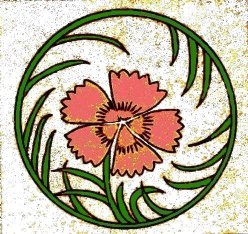 Sekichiku thru Sh |
|
Si thru Tengai |
Tengu thru Tsuzumi |
|
Yakusha thru Z |
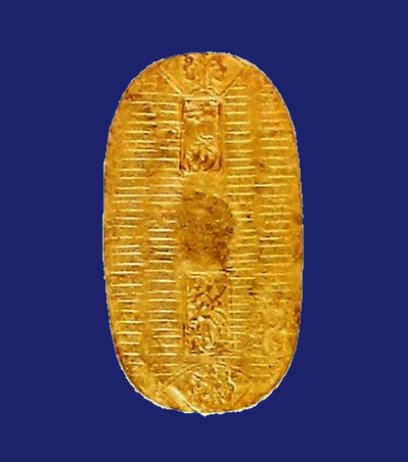
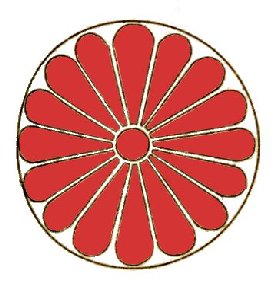
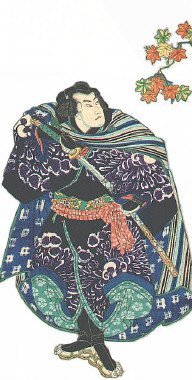
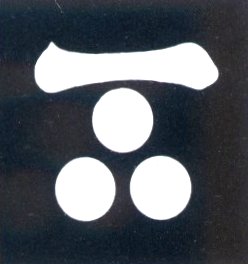
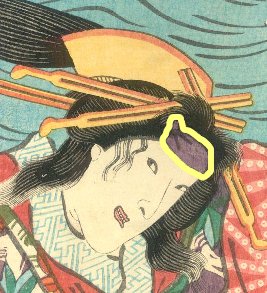
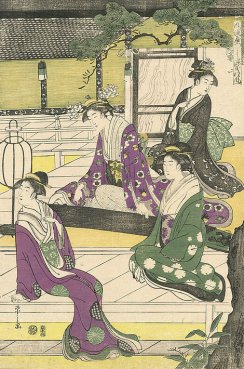
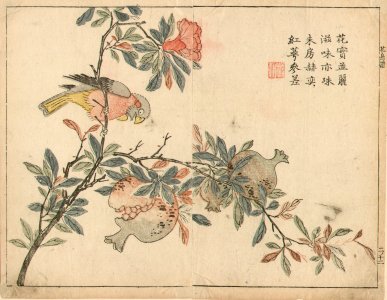
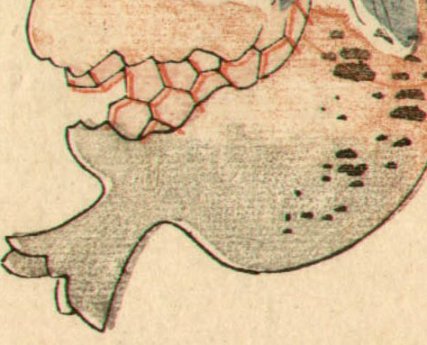
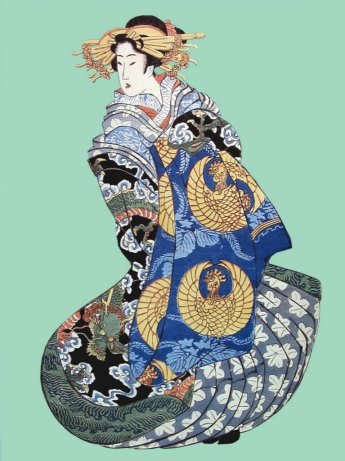
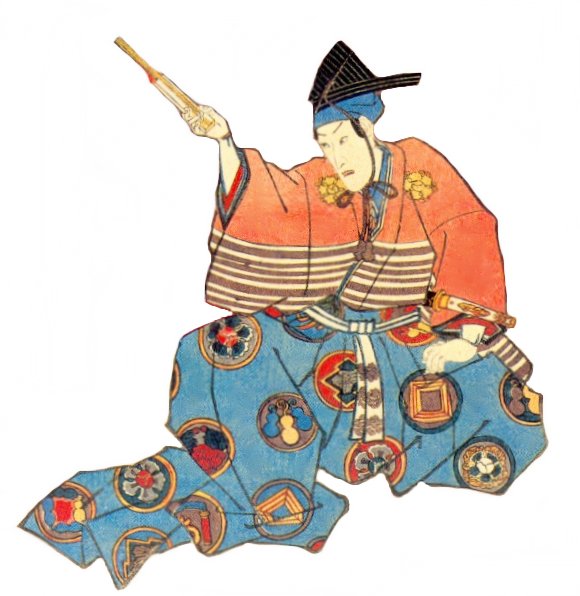
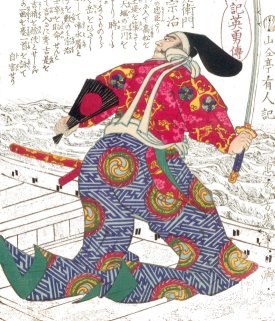
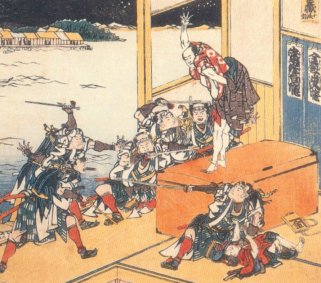
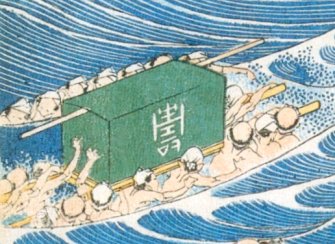
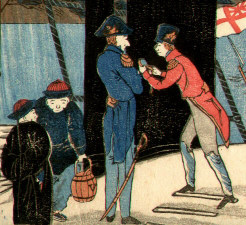
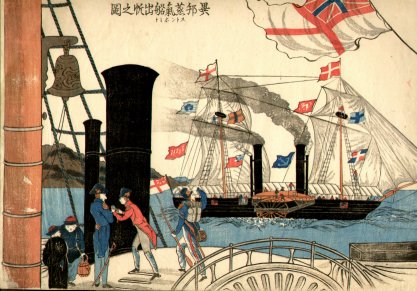
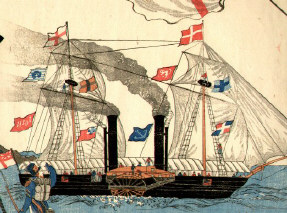
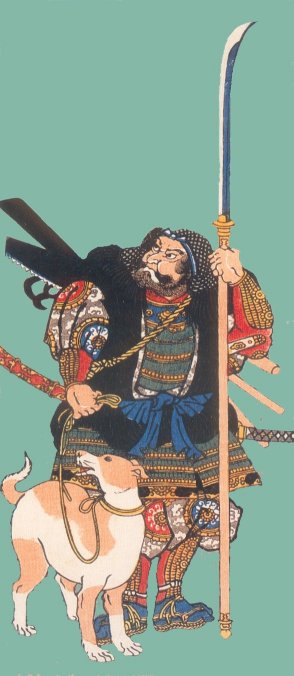
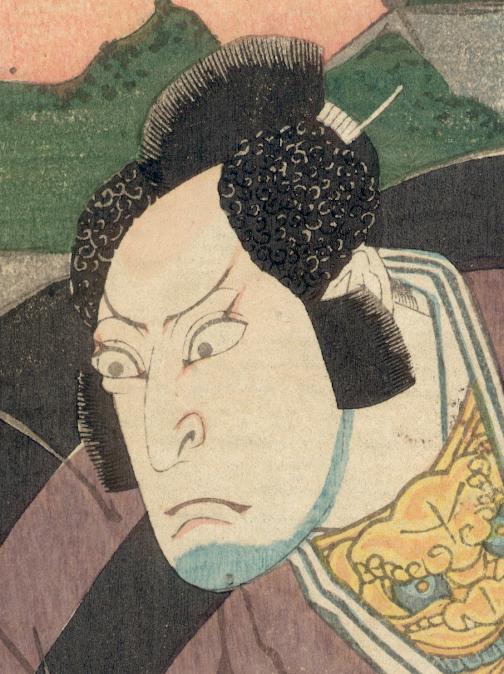
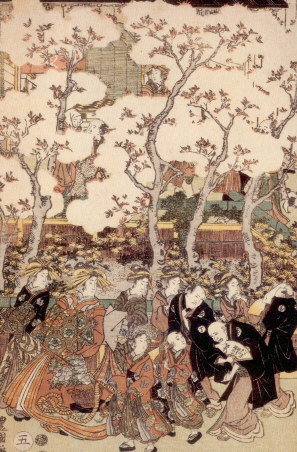
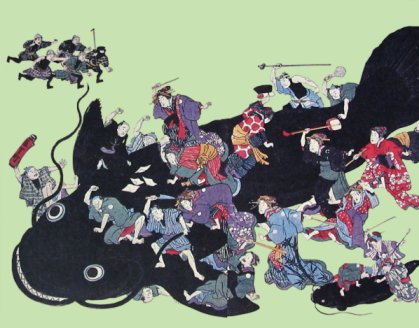
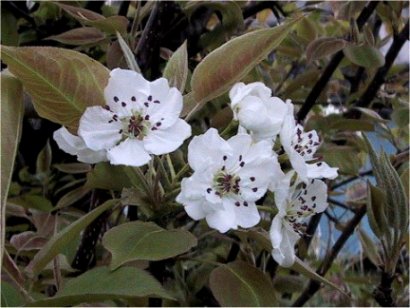
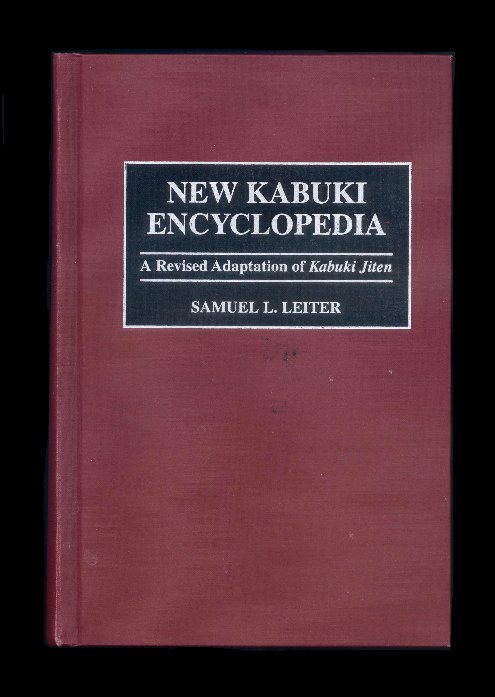
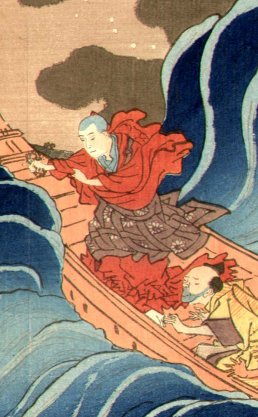
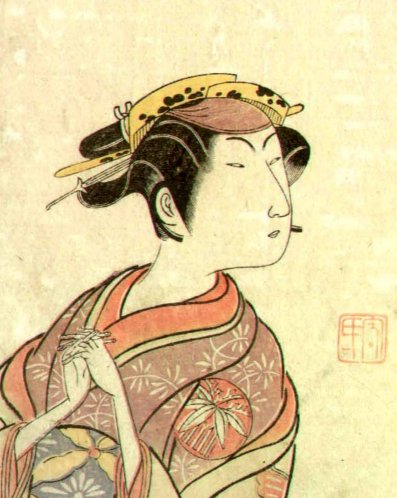
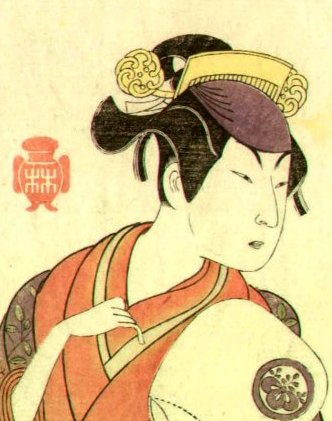
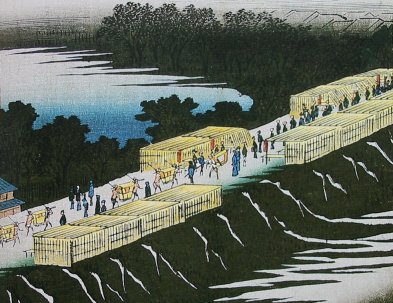
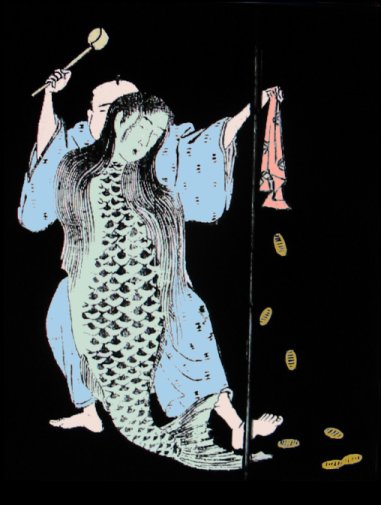
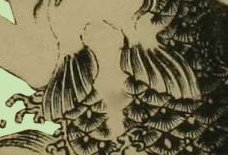
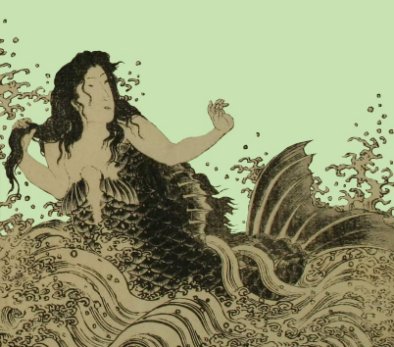
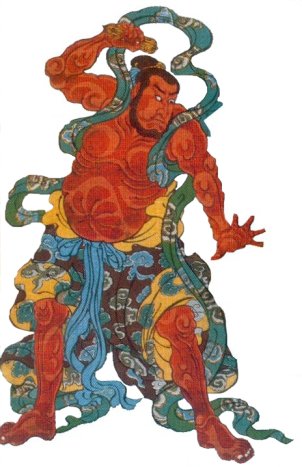
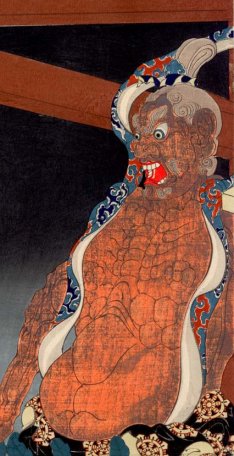
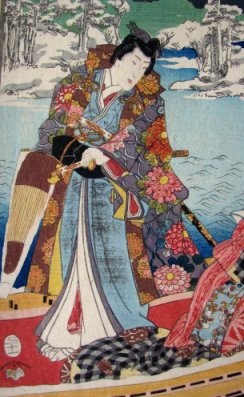
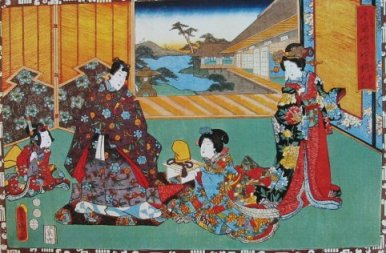
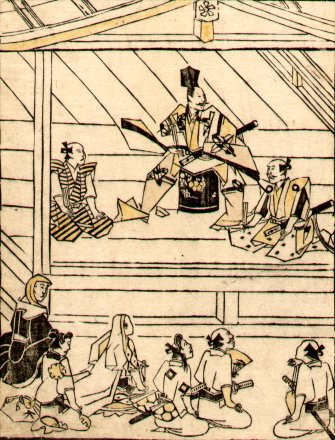
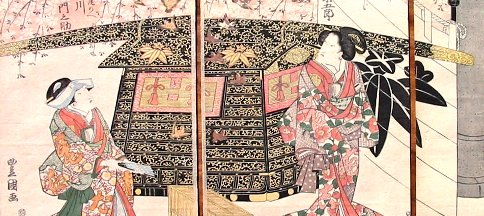
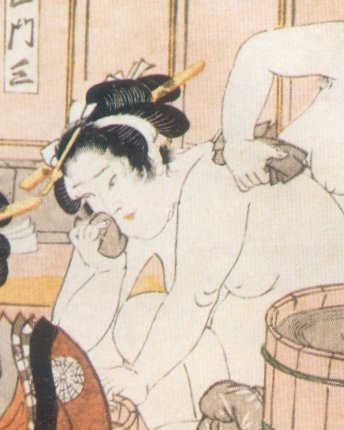
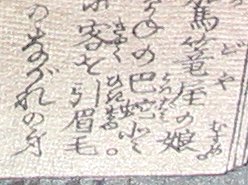
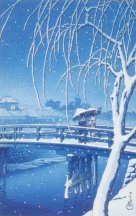
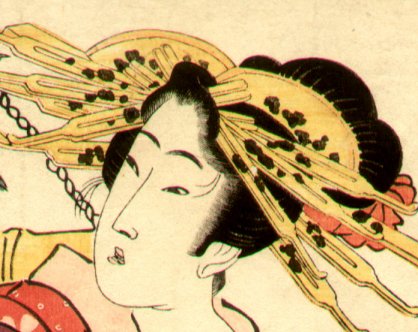


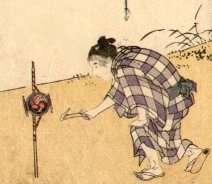
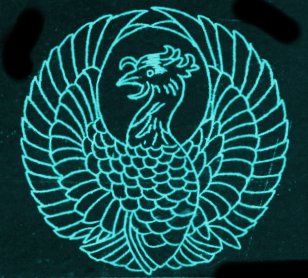
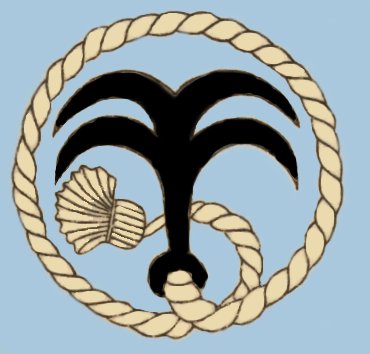
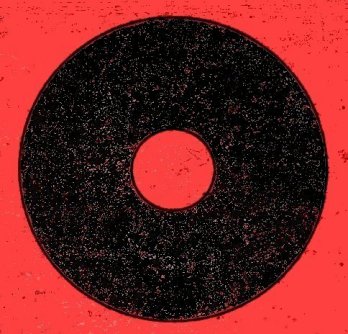
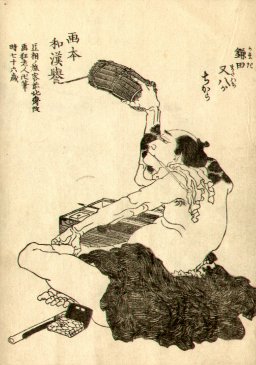
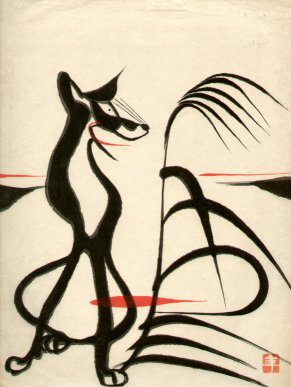
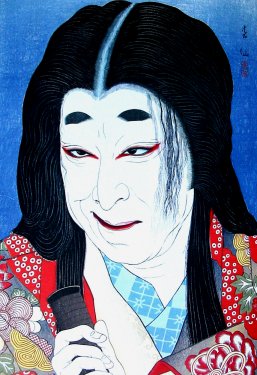
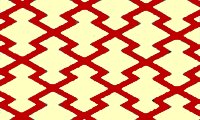
3.jpg)
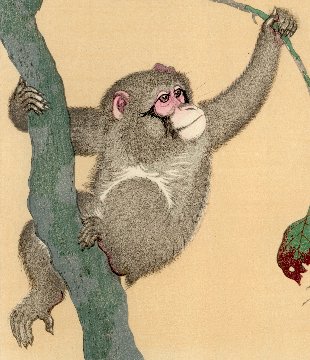
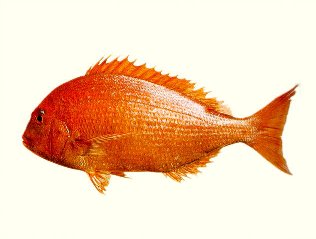
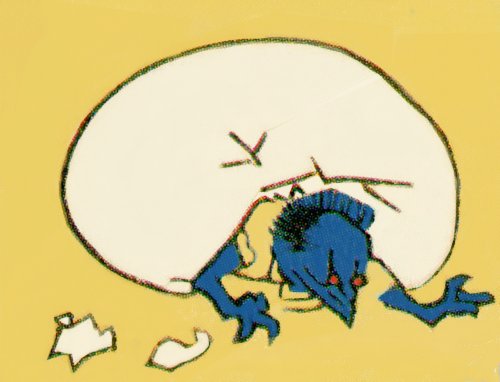
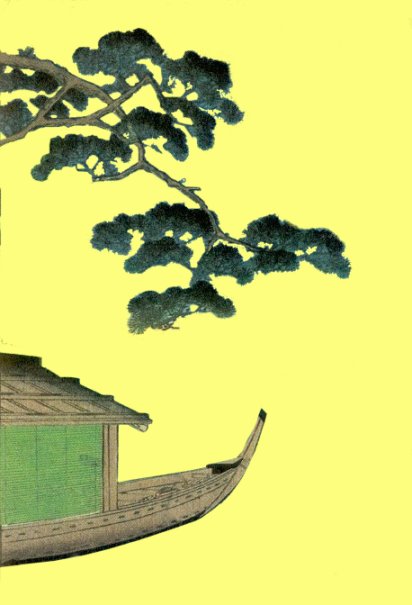
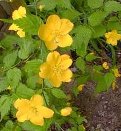
 HOME
HOME